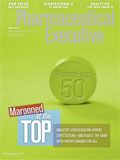Information Overload
Pharmaceutical Executive
Data has become as important as the drug in driving success in healthcare.
Information is the lifeblood of modern medicine—and like all things abundant, there is the central question: what to do with it? Pharmaceuticals companies believed for years that the pill was a stand-alone product rather than part of an integrated service offering. It followed that all the data compiled—from assay testing to the registration package to post-approval marketing and promotion—was seen as little more than a means to an end. The tipping point was that as the volume of data grew, it became intrusive. It attracted notice. At the same time, software technology was expanding in ways that opened new vistas of interpretation: all that data could be compiled, assessed, and applied to yield insights about everything surrounding the pill. It became possible to transform raw, disaggregated bits of information into organized, useful knowledge, with clear metrics to drive real differentiation against the competition.
In the last few years, the transformation in how Big Pharma uses information has become complete. What was formerly a functional sidebar—a storage headache—has become a strategic asset like intellectual property: a tangible source of value in its own right. Information not only tells Big Pharma where and how to best scale up its resources, it also repositions the industry for an educational role in persuading key stakeholders like physicians to change their behavior to lower the cost of treatment, based on appropriate drug interventions. Neil de Crescenzo, SVP of Oracle, points to three interrelated priorities that the pharma majors must focus on: building information "platforms" across all key operations, with the objective of finding synergies to drive speed and efficiency, thus lowering costs; exploiting new software applications to advance predictive analytics so that useful correlations in the expanding data stream can be uncovered to drive strategy and produce new insights about the customer mindset; and using data tools to foster more social collaborations around specific methods like gamification, which give companies a way to shape consumer behavior— with positive consequences in remedying historically elusive challenges such as improving poor rates of patient compliance. "The sky is the limit on the potential for creative use of the technologies now coming on stream," he says.
In the following special section, Pharm Exec casts additional light on the industry's slow transition toward an information-driven business, where data is a scalable—and sellable—part of its value proposition to a more diverse range of customers. We begin with a voice from the front line, Biogen Idec's Chief Information Officer, Raymond Pawlicki, who notes his greatest challenge is building a team with the versatility to connect the dots between insider techno-speak and the strategist's focus on the business—the big picture.
Next, Don Ragas of IMS offers up insights based on his own experience as a "data pruner" in asserting control of the data explosion—the digital world is forecast to hold upwards of 2.7 zettabytes of data by 2013, an amount equivalent to 700 billion DVDs—to help drive profitability through predictive analytics that help companies understand what customers actually do, not say. Another feature addresses the specific challenges in leveraging information to improve the speed and accuracy of regulatory submissions in obtaining a marketing authorization. Finally, we highlight three recent examples of progress in advancing patient access and outcomes through the creative use of information technology.
Throughout, our analysis—while acknowledging the speed and substance of new information applications—still puts the focus on the old-fashioned elements of function and process, where human will, skill, and ingenuity are essential to breathing practical life into the inanimate tool we call technology. Biogen Idec's Pawlicki puts it best—what comes first is creating and certifying efficiencies in-house: if you outsource a mess, expect to get an outsourced mess in return.

Trump: 'Major Tariff' on Pharmaceuticals Coming Soon
Published: April 9th 2025 | Updated: April 9th 2025“We’re going to tariff our pharmaceuticals, and once we do that, they are going to come rushing back into our country," President Donald J. Trump said during a Tuesday night dinner in Washington.